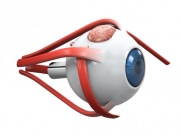Contents |
Convergence Excess
Introduction
There are six muscles attached to each eye called extra-ocular muscles that are responsible for moving the eyes in tandem in all directions. When they work as they should, in perfect synchrony, they help provide effortless coordination of the eyes at all distances and ranges of vision, all day long. (In figure 1 we see a diagram of how the muscles are attached to the globe.)
We need to be able to converge our eyes; while eyes looking straight ahead are not normally converged, when we read something up close, our eyes must converge somewhat so we don’t have double vision. But what happens when we converge too much?
Convergence
"Convergence excess" is the term used to describe an eye muscle imbalance, which causes a tendency for the eyes to want to aim more inwardly than needed. Usually, this mismatch between where the eyes aim and where the object is located in space has more of an effect on vision up close, as opposed to looking farther away. (In this context, “near” means vision used for reading or computer work, usually at a distance of about 16 inches or 40 cm. “Distance” describes vision that is aimed at least 20 feet away.)
When a convergence excess exists, it requires the muscle coordination system to work harder to maintain alignment of the eyes. Sometimes, the extra-ocular muscles are taxed beyond their power to maintain single, binocular vision and can result in episodes of diplopia (double vision), or even to a point where using both eyes is not possible. In cases like these, people will either see double most of the time; the brain wants to reject this, and learns to suppress at least the central vision from one eye. This can affect only one eye all the time, or it can alternate back and forth between the two. The medical term for this condition is "strabismus". "Esotropia" is a type of strabismus where one eye turns inward, rather than outward.
In the milder forms of convergence excess, we refer to it as "esophoria".
Symptoms of esophoria may include blurred vision at distance, near or both; headaches; intermittent diplopia; ocular fatigue; a drawing or pulling sensation around the eyes; excess blinking and head tilting. Dizziness, a tendency for motion sickness and an avoidance of near tasks such as reading, writing or computer use are also reported. Obviously, academic performance will suffer when children are esophoric.
Treatment
In children, vision therapy exercises, also known as vision training or VT, is preferred for a better long-term reduction of convergence excess. Prescription eyewear may be helpful in training for reducing the amount of muscle power required to read without symptoms. The goal of such therapy is to allow the eyes to aim normally and without undue effort.
In adults, a combination of eyeglass lenses, prisms and some VT is very helpful. In cases where the tendency to over-converge the eyes is larger at near than at distance, lenses to help in focusing can make quite a difference, because when the eye focuses, it also triggers more convergence in the brain. When the focusing effort is reduced with lenses, the convergence also lessens. This is even more important when there is an uncorrected refractive error, especially farsightedness, or "hyperopia". Another situation that contributes to esophoria is a significant difference of vision between the two eyes, where one is more farsighted than the other. High astigmatism in one eye can also cause amblyopia, which contributes to unbalanced ocular muscles.
Most of us know that a prism can separate white light into its component colors, but because they do re-direct light, prisms are very useful in training the eye muscles to work properly, or they may be incorporated into a spectacle lens prescription to allow for easier and less stressful vision, particularly at near.
The difference between a prism that is used as a tool to train the eye muscles is this: when a prism is placed in front of one eye, the eye must move to keep focusing on a target. When prisms are used in spectacle lenses, they allow the eyes to be in the position where they are most comfortable, to provide constant, single vision.
Figure 2: Siamese cats are famous for being strabismic, that is, having eyes that cross.
Esotropia
The more advanced forms of convergence excess, as noted above, can result in a type of strabismus called esotropia. In esotropia, the tendency for the eyes to over-converge is too strong for the brain to overcome without suppressing the vision from one eye. This results in an eye turn that is usually visible to others and which can become a cosmetic problem as well as a functional one. While VT is quite successful for the long-term relief of eyestrain symptoms of esophoria or the milder forms of esotropia, overcoming a large amount of over-convergence can be problematic and may require eye muscle surgery to re-align the eyes physically, followed by VT to strengthen and maintain binocular vision.
To help break up the suppression adaptation the brain has made to the double vision that would result when both eyes are not aimed at the same place, a patch over the better eye can be helpful. Patching alternate eyes can also be a useful tool in overcoming suppression. However, in some esotropia patients, the condition known as amblyopia occurs, where the vision in the turned eye never truly develops normally. While short-term patching of the better eye may help in VT, long-term patching for strabismic amblyopia is not considered to be helpful after the age of 5 or 6 years.
Summing Up
The milder forms of esophoria and convergence excess respond well to lenses, prisms and VT exercises in both children and adults.
In more extreme cases, such as esotropia and amblyopia, ocular muscle surgery will help provide a good basis for VT to work from for long-term treatment. Most eyecare practitioners recommend that muscle surgery, however, should be reinforced by VT to help maintain the alignment achieved.
Using a computer and reading are activities that should not be denied to anyone because of a relatively simple-to-treat condition of convergence excess. With a little help from an eyecare practitioner, it is possible to improve binocularity to a point where vision at any distance is no longer such a chore.







